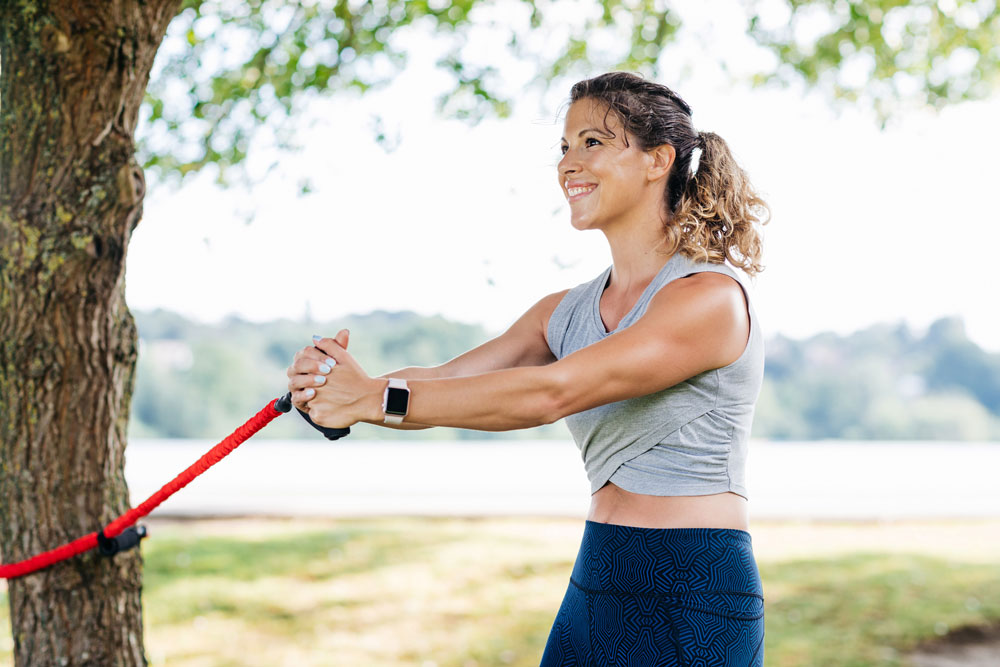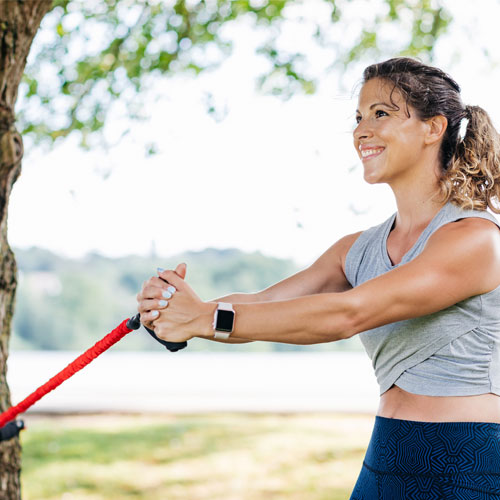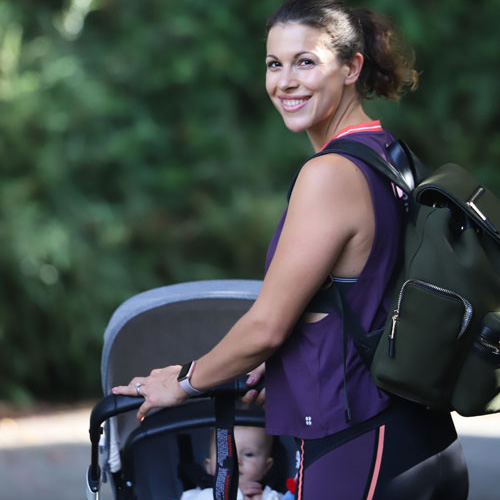Until about six years ago, I treated my menstrual cycle synonymously with my period. The only thing I was keen to align was the absence of my period and my next scheduled weekend away. For every social invite, I’d consult the proximity of the next dismissively scrawled ‘P’ in my diary before confirming my attendance. But when my husband and I were soon to consider conceiving, that monthly marker became less a warning signal and more a beacon of possibility and opportunity.
For nearly three decades, I’d believed my period was just like its grammatical namesake: a full stop. A time to retreat and wait for normal life, exercise and productivity to resume. But that’s where I was wrong. A woman’s period is – physiologically, reproductively, and socioculturally – only ever the beginning. It is the literal cleansing of the uterus. A foundational step to pre-empt the release of a new egg. The green light for a new wave of oestrogen to sweep in and sweep us up in a burst of physical and social activity for which we’re physiologically primed. It’s the only common variable by which every woman can identify the beginning of her cycle. It’s the blank space beneath a new chapter heading.
So much more the capital first letter than the dot at the end of a sentence, why was the period dismissed as a measly punctuation mark? This misconception was certainly reinforced by common practice in the 90s, 00s and 10s to prescribe hormonal contraception for every young woman with acne, headaches, heavy or painful periods, mood swings and, even, elite athletic aspirations. A blister pack of 21 or 28 magic pills of predictability, endorsed by medical practitioners and even sports coaches trained to edit out and overlook the singlemost important indicator of a woman’s health.

The cock-up of contraception
Whatever you think of hormonal contraceptive, and however you interpret the limited and conflicting research on its long-term use, the vilification of female sex hormones is a unifying experience for women who came of age in the last 30 years. The favoured solution to their fluctuating nature was to control their fluctuations by adding more hormones. To manipulate its variability into consistency and stability. For the better part of three decades (maybe more?), we’ve been trying to stomp the natural undulations of our cycles into a flat line. Well, that logic is flatlining.
Like the axis-shifting revelation that the Earth is round and not flat, the 2020s will be the decade we unpick the misperception that cyclical is unpredictable, and finally begin to understand and harness the power of the menstrual cycle as nature intended. When assessing the quality of a lab study, we look at its results and how reproducible they are. If we analyse the menstrual cycle as a study in female physiology, there is no outcome more reproducible. Sure, hormones rise and fall, but they do it again, and again, and again. While deviation from these patterns for a single individual may be a useful cry for help from her body, deviations from person to person usually fall within a familiar, reassuring pattern to self-monitor and use to our advantage. Read that again. To. Our. Advantage.
Already studies are highlighting the natural phenomenon of female sex hormones and their practical benefits. It’s telling that female anatomy, sexual desire and periods are all fair game for comic relief – as evidenced by the popularity (and hilarity!) of Hayley Morris’ Me vs Brain reels on Instagram. It’s when we’re comfortable enough to laugh about something, that we get closer to understanding it.
I should add that oral contraception for its intended purpose – contraception – was and is an invaluable resource for women’s rights. This I cannot be too quick to clarify, when questionably regressive decisions are being made for women in a country with the power and responsibility to set positive and progressive standards. Yet, for many, birth control is secondary in their decision to take oral contraceptives, and for those women we need to reevaluate the menstrual cycle as a tool for better understanding and improving our wellbeing.

The simplest way to understand the menstrual cycle is in two phases – although there are also four-phase models likened to the seasons, for those who want to find more parallels in the cycles around us. The first phase is the Follicular Phase: it starts with the period, ends with ovulation, sees the highest rise of oestrogen, thrives on carbohydrates for energy, has the greatest potential for both strength and aerobic gains and the lowest risk of injury. The second phase is the Luteal Phase: it starts with ovulation, ends with the period, sees the highest rise of progesterone, prefers fat for energy and is typically a good time to consolidate training gains or include a down-training week.
When the menstrual cycle deviates from this, it’s called menstrual dysfunction. Unfortunately, menstrual dysfunction rarely exists in isolation. The Female Health Triad, first recognised in the 90s, identified menstrual dysfunction as sharing commonly interrelated conditions of low bone mineral density and nutritional deficiency. The menstrual cycle went from a cringey inconvenience to a highly advantageous litmus test for female wellbeing. It wasn’t until 2014, when the International Olympic Committee renamed it RED-S (Relative Energy Deficiency in Sport), that it became more common (but still not that common) to talk about the menstrual cycle when treating and training women. Eight years later, we still have so much to learn.
Less maverick, more mentor; What the menstrual cycle teaches us
I’m including a graph published by zrtlab.com, which is one of the best depictions of the two-phase menstrual cycle I’ve seen. The corresponding article is also a brilliant synopsis of some of the most important and current research and the impact it may have on female performance, for those inclined to dive deeper into the science. It draws on much of the same data that inspired the scientists behind cycle tracking app FitrWoman to automatically match the tangible events within your body to the corresponding physiology you cannot see. It helps to flag experiences which repeat at similar times of your cycle, become better at anticipating changes in your body and even appreciate how you can better support your body throughout your cycle.
There are many things we can learn from our menstrual cycle. Already I’m drafting a listicle to highlight the headline lessons without drowning out the intended social observation of today’s piece. One thing that does stand out to me is how divisive the observational studies are, particularly those which ask their subjects about the perceived effect of either A) having a natural period or B) taking oral contraceptives to manipulate their periods. In both cases, around half of women report training and/or feeling better on oral contraceptives, while half report training and/or feeling better when they come off oral contraceptives. We know that our perception dramatically affects our experience (hello again, neuroplasticity!), so I wonder how much better we can make our experience when we commit to learning about and even celebrating our menstrual cycles.
It could well mean changing the way we assess success – particularly in the way we train, looking for different outcomes at optimal times of our cycles and therefore giving ourselves more reasons to call each workout a win. It may even mean looking at our monthly schedules differently, so we are more productive and get more enjoyment out of the things with which we fill our diaries. Maisie Hill’s book Period Power explores this idea in depth. I’d even hazard to say it will improve our understanding of perimenopause, as learning to intuit a regular cycle can only make us more conscious of deviations to those cycles. More awareness brings more curiosity, so perhaps it’s also the foundation that ushers in more research dedicated to understanding and enhancing the female experience. Hazel Wallace’s new book The Female Factor considers the male bias in medical research and attempts to fill some of the practical gaps left by that bias. It’s an important step in educating the women who are asking the questions, so that our experts have to start finding better answers.
Shifting the female contraceptive burden
I do hope that some of the answers come in the form of male-led contraceptives. A huge part of the menstrual cycle’s misconception as an inconvenience does of course come down to the female burden to prevent pregnancy. I’m someone who’s body has steadfastly denied every form of female contraception. Most recently, my uterus left-hooked the copper coil to the curb with debilitating 14-day periods, rendering my own ultra-regular 28-day cycle nearly unrecognisable. Non-hormonal contraception seemed like an obvious winner, but restoring my body’s status quo feels less like losing and more like a return to self. My period played a similar role when it emerged after my 14 months of breastfeeding twins. I saw it as my body’s signal to let my own identity re-surface alongside the maternal role that had blurred my individuality. Mind, I will be handing the pregnancy prevention baton back to my husband until something better comes along (the rhythm method, Natural Cycles, etc, I’ll be watching you). As much as I do adore our three small children, the procreative cycle is one I’ve pedalled enough in this season of life.
I started this piece talking about one type of cycle. As time has passed, I’ve noticed so many more around me. Seasons. Generations. Relationships. Creative processes. Societal shifts. The years that start in January and the years that start in September. When we begin to appreciate our own internal cycles, it opens our world to how natural – even predictable – it is to find cycles everywhere we look. There’s something beautiful in the crest and shallow of a wave; in the way neither lasts for long. In a fast-paced age when there is so much drive for progress and growth, cycles offer both a grounding constant and the recurring opportunity to catch the next wave of change. Understanding the world as a series of cycles – including our lives and the bodies in which we live them – creates more space to grow, and simultaneously less pressure to do so.
At nearly 34, I likely have fewer years with a regular menstrual cycle ahead of me than I have behind me, so I’m happy I can live and train in harmony with my cycle while it’s here.





